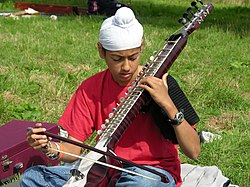Esraj: Difference between revisions
Quisqualis (talk | contribs) →Notable Figures: links, removed unsourced, suspect and non-notable entries |
|||
| Line 30: | Line 30: | ||
==Notable Figures== |
==Notable Figures== |
||
| ⚫ | |||
*[[Guru Gobind Singh]] |
|||
*Pandit Ashesh Banerjee |
|||
| ⚫ | |||
*[[Pandit Shiv Dayal Batish]] |
*[[Pandit Shiv Dayal Batish]] |
||
| ⚫ | |||
*Pandit Ranadhir Ray |
|||
*[[Kalipada Ghoshal]] |
|||
*Buddhadeb Das |
|||
| ⚫ | |||
*[[Ravi Shankar]] |
*[[Ravi Shankar]] |
||
*[[S. N. Bose]] |
*[[S. N. Bose]] |
||
| ⚫ | |||
*Sukesh Jana |
|||
*Arshad Khan |
|||
*Subhayu Sen Majumder |
|||
*Abir Singh Khangura |
|||
*Alexandre Jurain |
|||
*Jonathan Kay |
|||
*Sougata Das |
|||
| ⚫ | |||
== See also == |
== See also == |
||
Revision as of 21:43, 5 January 2019
This article needs additional citations for verification. (July 2018) |
 A Sikh boy playing the Esraj | |
| String instrument | |
|---|---|
| Other names | Dilruba |
| Classification | Bowed string instrument |
| Developed | 17th century |
| Related instruments | |
Esraj (Template:Lang-pa (Gurmukhi); modern variant of the Dilruba (Punjabi: ਦਿਲਰੂਬਾ (Gurmukhi)) is a string instrument played with a bow originating from the southern region of Asia. It is a relatively recent instrument, being only about 300 years old; primarily found in traditional eastern Bengal (Bangladesh)—being the area historically where renowned literature, poetry and music arrived from and in Punjab, where it is used in Sikh music and Hindustani classical compositions, and in West Bengal. The history and origin of the instrument is often disputed.
The dilruba and its variant, the esraj, had been declining in popularity for many decades. By the 1980s, the instrument was nearly extinct. However, with the rising influence of the "Gurmat Sangeet" movement, the instrument has been once again attracting attention. Despite the decline, it still remained popular in Bangladeshi music.
History
The dilruba was created some 300 years ago by the 10th Sikh guru, Guru Gobind Singh, who based it on the much older, and heavier, taus[1][2] This made it more convenient for the Khalsa, the Sikh army, to carry the instrument on horseback.
Construction styles
The dilruba and its variant, the esraj, have a similar yet distinct construction style, with each having a medium-sized sitar-like neck with 20 heavy metal frets. This neck carries a long wooden rack of 12–15 sympathetic strings. While the dilruba has more sympathetic strings and a differently shaped body than the esraj, they both have four main strings which are bowed. All strings are metal. The soundboard is a stretched piece of goatskin similar to what is found on a sarangi. Occasionally, the instrument has a gourd affixed to the top for balance or for tone enhancement.
Playing
The instrument can be rested between the knees while the player kneels, or more commonly rested on the knee of the player while sitting, or also on the floor just in front of the player, with the neck leaning on the left shoulder. It is played with a bow (known as a "gaz"), with the other hand moving along the strings over the frets. The player may slide the note up or down to achieve the portamento, or meend.
Notable Figures
- Asian Music Circle, used in George Harrison's "Within You Without You"
- Pandit Shiv Dayal Batish
- Sri Chinmoy
- Ravi Shankar
- S. N. Bose
- Joel Goldsmith
See also
References
- ^ Dutta, Madhumita (2008). Let's Know Music and Musical Instruments of India. Star Publications. pp. 22–23. ISBN 978-1-9058-6329-7.
- ^ Dharam Singh (2001). Perspectives on Sikhism. Publication Bureau, Punjabi University. p. 158. ISBN 978-8-1738-0736-7.
